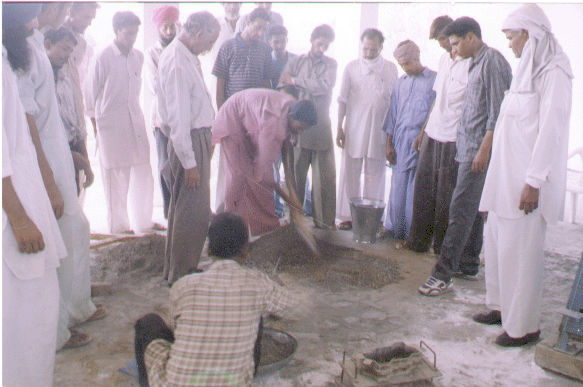Steps towards industrial
waste utilisation for manufacturing building products
Anand Choudhary
|
Considerable research work
has been done by number of R&D organisations in India regarding the
utilisation of industrial waste for manufacturing building products.
This article is focuses on the
utilisation of two industrial by-products: fly ash and marble slurry in
Bathinda, Punjab and Southern Rajasthan respectively.
Use of Fly ash
in Bathinda
Bathinda is a district situated
in south of Punjab, one of the fastest growing industrial states of
India. Besides agriculture and mechanical industry, which play a key
role in the development of this region, this district has 3 thermal
power plants (TPPs), which supply electricity to most of the regions in
south and west Punjab. |

|
|
Flyash
Block production training in Bathinda |
From these TPPs enormous amount
of fly ash is generated. Inspite of huge expenditure and investments to dump it
safely, unmanageable magnitude of fly ash causes serious environmental &
health hazards.
To find an appropriate solution, District Rural Development Authority (DRDA) of
Bathinda invited Development Alternatives to suggest and appropriate use of this
material in manufacturing building products.
For this purpose, a 12 day training programme was held at the Building Centre of
village Kaljharani (30 km away from Bathinda town) which is a part of self-
employment project of this district. The objectives of this training programme
was to utilise fly ash as a walling material and to introduce micro enterprise
based sustainable building technologies to create employment opportunities for
the rural youth.
Technologies included fly ash blocks as a walling product, Micro Concrete
Roofing Tiles (MCR) for sloping roofs and concrete blocks for pavements.
With the co-ordination of local administration and efforts of sincere and
industrious trainees, the programme achieved more than its set objectives
resulting in a permanent building centre for training and production of these
technologies, run by the rural youth.
Use of Marble Slurry in
Rajasthan
Rajasthan is bestowed with enormous
quantities of rich mineral deposits. From the marble belt of southern Rajasthan,
more than 2.5 million tonnes of marble is extracted every year. The industry has
a vital role in the economic development of this region.
On the other side of this bright picture are major problems which cause severe
environmental and health hazards. Huge marble blocks from the quarry are cut
into thin slabs with the help of gang saws. The blade thickness of these saws is
about 5mm, therefore, for every 20mm slab, 5 mm of thickness is converted into
powder. In addition the production process requires huge quantities of water,
which acts as a coolant. Thus, the total waste generation comprising of 20% of
powered marble and large quantities of water becomes 50% of the total mineral
mined.
The large quantities of marble slurry are either piled as huge mounds or dumped
on road sides and seasonal river beds.
Major problems associated with marble slurry generation are:
w Dried
marble powder from the mounds mixes with air, forms fugitive dust affecting
visibility and becomes an eye
sore.
w Its deposition on dried riverbeds, blocks flow of
water thus seriously affecting underground water availability.
w Its dumping adversely affects soil productivity, by
decreasing porosity, water absorption, water percolation etc.
w In the rainy season, with flowing water, slurry is
carried over to the rivers and other water bodies, severely
affecting aquatic life and water storage capacities.
The Udaipur Chamber of Commerce and Industry (UCCI), along with SDC (Swiss
Agency for Development and Co-operation) now working towards the utilisation of
marble slurry and reducing environmental hazards caused by it.
Various research organisation like Central Building Research Institute (CBRI)
Roorkee, Central Power Research Institute (CPRI) Bangalore, Central Road
Research Institute (CRRI) Delhi etc. have been working on projects to enhance
marble slurry utilisation in manufacturing building products. The UCCI organised
a seminar on gainful utilisation of marble slurry in building products on 18th
September, 2000. Scientists from CPRI, CRRI, CBRI, of the Indian Environmental
Society, highlighted their research activities and building products associated
with marble slurry utilisation.
Development Alternatives was also invited to this seminar to present its work on
appropriate building technologies and micro enterprise development. As a next
step to this phase of R&D, UCCI has felt the need for micro building
material enterprises in the region. After visiting Development Alternatives’
building centre at Delhi, UCCI is considering the introduction of some
alternative building technologies, which will be promoted as micro enterprises.
It is hoped that UCCI’s approach of micro enterprise development will be an
important step towards marble slurry utilisation and overall prosperity of the
region. q
The author
is Building Technologist
at Development Alternatives,
Email: anandc@sdalt.ernet.in

